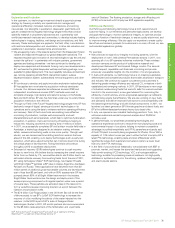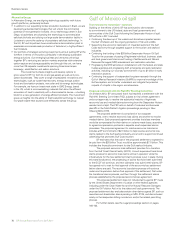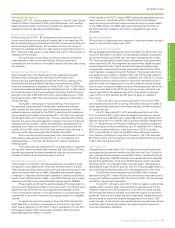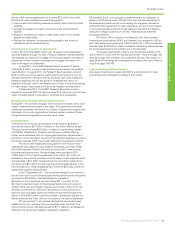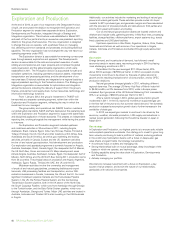BP 2011 Annual Report Download - page 72
Download and view the complete annual report
Please find page 72 of the 2011 BP annual report below. You can navigate through the pages in the report by either clicking on the pages listed below, or by using the keyword search tool below to find specific information within the annual report.
70 BP Annual Report and Form 20-F 2011
Business review
The Deepwater Horizon oil spill demanded a response at an order of
magnitude never required before. We learned a great deal and made
advances in response technology and systems. As a result we are updating
our group requirements and are sharing our knowledge with the industry
and regulators.
In 2012, we will be working on the development of enhanced
oil spill preparedness and response requirements for all BP entities that
handle oil in a way that gives rise to a risk of an oil spill. Once these
requirements are incorporated into OMS, they will require relevant
businesses to follow a planning process to predict how the spilled oil will
behave; identify, assess and understand the environmental and social
sensitivities at risk; define effective response strategies and confirm that
appropriate response capabilities are in place. This practice will incorporate
our deepwater technical requirements, further enabling a single, consistent
process across BP.
Sensitivity mapping
Understanding the environmental and socio-economic sensitivities where
we operate is an important part of planning for an effective response. We
obtain sensitivity information from many sources, including environmental
and social impact assessments (ESIAs) for many of our projects. These
ESIAs include information about the potential environmental and socio-
economic impacts of planned activities and also the potential impacts that
might occur in the event of an unplanned event, such as an oil spill. In 2011,
we have used high resolution satellite imagery to enhance our sensitivity
mapping across thousands of miles of coastlines, and submersibles to
characterize the deep ocean. This has helped us better understand our
environmental risks in regions like Angola, Brazil and the US.
Contingency planning
Identifying and assessing environmentally and socio-economically
sensitive areas helps us to develop appropriate oil spill response and crisis
management plans. The objective is to use response techniques to avoid
or minimize the environmental and socio-economic impact of a spill to the
extent feasible based upon an assessment of the sensitivity of the local
environment. These plans are backed up by robust response ‘capability’, the
tools and people required to mount an effective response to an incident.
How we work with designated government regulatory bodies in
the event of a spill is critical. Sharing lessons learned and maintaining a
dialogue with regulators in the regions where we operate is an important
part of our approach. In many countries where BP operates, the regulator
will ultimately determine the procedures to deal with the environmental and
socio-economic impact.
Acute response plans are often focused on the physical
containment and recovery of the spilled oil, though they also recognize that
components in dispersed oil will be subject to processes of biodegradation,
which may be facilitated and accelerated by the application of chemical
dispersants.
For onshore operations, for example, BP refineries’ spill response
plans include passive and active containment measures that are designed
for the specific location and types of operations.
In the event of concurrent spills at multiple locations, each affected
facility would activate its independent oil spill response plan and respond
accordingly. Although responding to multiple spills of the same magnitude
and complexity as occurred in the Gulf of Mexico in 2010 would be a
challenge for the group, our response plans are not interdependent.
See Safety on pages 65-69 for further information on BP’s approach
to oil spill prevention and preparedness.
Gulf of Mexico – our long-term commitments
See Gulf of Mexico oil spill on pages 76-79 for further information on
BP’s response to the incident and environment and economic restoration
efforts.
Canadian oil sands
Canada’s oil sands are believed to hold one of the world’s largest untapped
supplies of oil, third in size to the resources in Saudi Arabia and Venezuela.
BP is involved in three oil sands projects, all of which are located in the
province of Alberta. Development of the Sunrise project, our joint venture
operated by Husky Energy, is under way, with production from Phase 1
expected to start in 2014. The other two proposed projects – Pike, which
will be operated by Devon, and Terre de Grace, which will be BP-operated
– are still in the early stages of development.
We reviewed and approved the decision to invest in Canadian oil
sands projects, taking into consideration greenhouse gas (GHG) emissions,
impacts on land, water use and local communities, and commercial
viability. As with all joint ventures in which we are not the operator, we will
monitor the progress of these projects and the mitigation of risk.
The extraction process to be used, in situ steam-assisted
gravity drainage (SAGD) technology, involves the injection of steam
underground. The steam liquefies the bitumen, allowing it to flow to the
surface through production wells. This production technique reduces land
disturbance and aligns to our strengths, particularly to our expertise with
wells and improving large-scale reservoir performance. Unlike mining,
in situ processes create a smaller physical footprint and do not involve
tailing ponds.
A key concern around oil sands operations using SAGD is the
amount of greenhouse gas emissions produced for steam generation
and the processing of the produced bitumen. A ‘well-to-wheels’ study
conducted in 2009, which measured total GHG emissions from production
through to consumption, found the lifecycle emissions for oil sands-based
products to be 5-15% higher than those from products from average crude
oils consumed in the US.
Climate change
Climate change represents a significant challenge for society, the energy
industry and BP. In response to the challenges and opportunities, BP is
taking a number of practical steps, including investing in lower-carbon
energy products such as biofuels and wind, and ventures focused on
sustainable energy solutions; and seeking to manage our own GHG
emissions through a focus on operational energy efficiency, reductions
in flaring and venting and the engineering design for new projects. We
see natural gas playing a key strategic role as a lower-carbon fuel that is
increasingly secure and affordable. We also consider the potential impacts
of a changing climate on our operations.
Greenhouse gas emissions
Our direct GHG emissionsa were 61.8 million tonnes (Mte) in 2011,
compared with 64.9 Mte in 2010. This decrease of 3.1 Mte is primarily
explained by the temporary reduction in activity in some of our businesses
as a result of maintenance work and also by the sale of assets as part of
our disposal programme. We achieved 0.2 Mte of sustainable emissions
reductions in 2011.
Over the long-term it is likely that the carbon intensity of parts of
our business will increase. In our upstream operations this is because
we expect to move further into technically difficult and potentially more
energy intensive areas. The intensity of certain refining operations may also
increase with the trend towards processing heavier crudes which requires
more energy.
In 2010 we did not report on GHG emissions associated with
the Deepwater Horizon incident or response. We have since estimated
the CO2 equivalent emissions from response activities in 2010 to be
approximately 481,000 metric tonnes, which includes major vessels
deployed. This figure does not include emissions associated with the
‘vessels of opportunity programme’, the onshore vehicles and equipment
and the incident itself, which are estimated to be minor.
a We report GHG emissions on a CO2-equivalent basis, including CO2 and methane. This represents
all consolidated entities and BP’s share of equity-accounted entities except TNK-BP.

















